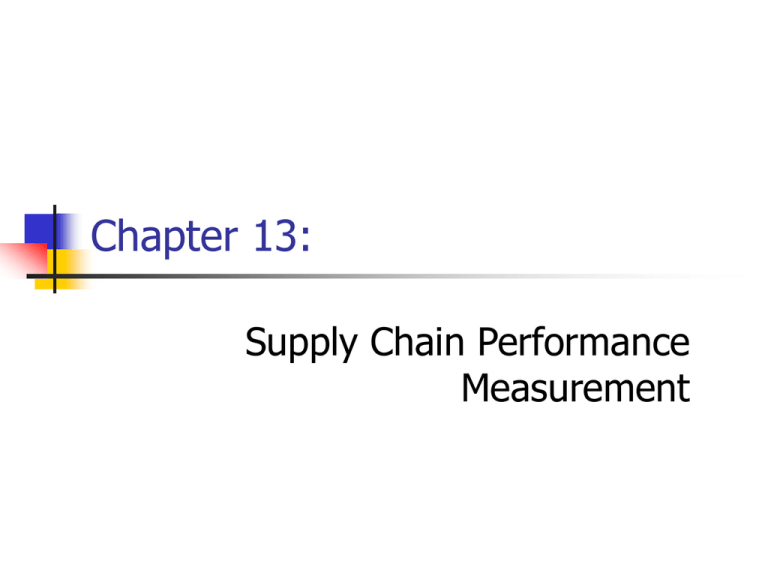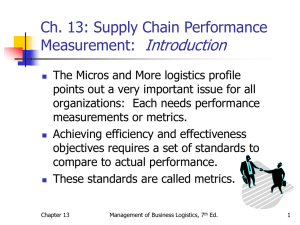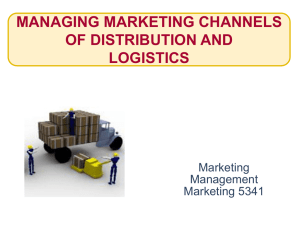Chapter 13
advertisement

Chapter 13: Supply Chain Performance Measurement Logistics Profile: Micros and More…A Final Sequel “If you can’t measure it, you can’t manage it.”; Micros and More was uncertain if their recent gains were appropriate. Micros and More was unsure about ‘where they are’ and ‘where they have been’; this makes it difficult to evaluate performance. Developing a set of performance metrics will help Micros and More chart a course for the future and evaluate their performance along the way. Chapter 13 Management of Business Logistics, 7th Ed. 2 Supply Chain Performance Measurement: Introduction The Micros and More logistics profile points out a very important issue for all organizations: Each needs performance measurements or metrics. Achieving efficiency and effectiveness objectives requires a set of standards to compare to actual performance. These standards are called metrics. Chapter 13 Management of Business Logistics, 7th Ed. 3 Dimensions of Performance Metrics Establishing appropriate metrics is a complex problem. Measuring inappropriate performance can lead to a company chasing the wrong goal. Metrics drive behavior --- what you measure is what you get. Logistics cost metrics should focus on the total supply chain, not on just one link. Chapter 13 Management of Business Logistics, 7th Ed. 4 Figure 13-1 Raising the Performance Bar Chapter 13 Management of Business Logistics, 7th Ed. 5 Overview of Performance Measurement1 Figure 13-2 contains a list of performance measures captured on a regular basis within companies. Knowing what metrics to use is a very important issue. Figure 13-3 provides some insight into the characteristics of good performance measures. Chapter 13 Management of Business Logistics, 7th Ed. 6 Figure 13-2 Measures Captured on a Regular Basis Within the Company Chapter 13 Management of Business Logistics, 7th Ed. 7 Figure 13-3 Characteristics of Good Measures Chapter 13 Management of Business Logistics, 7th Ed. 8 Other Useful Performance Guidelines2 The metrics must be consistent with overall corporate strategy. The metrics must focus on customer needs and expectations. Prioritize your metrics. Focus upon processes not functions. Chapter 13 Use a balanced approach in selecting and developing metrics. Precise cost measurement is an important aspect for gauging improvement. Use technology to enhance efficient performance measurement. Management of Business Logistics, 7th Ed. 9 On the Line: Measuring Performance The current economic slowdown has sent many companies looking for ways to cut costs and improve productivity without increasing resources. By establishing performance metrics throughout the supply chain, companies are more likely to reach overall corporate goals. Systems such as KPIs, SCOR, and e-SCOR are being used to develop these metrics. Chapter 13 Management of Business Logistics, 7th Ed. 10 categorizations 1. 2. 3. 4. Evolution of Metrics Utilization Performance Categories Another Approach Supply Chain matrix Chapter 13 Management of Business Logistics, 7th Ed. 11 1. Evolution of Metrics Utilization Most organizations go through several phases in the development of meaningful metrics: Stage 1 – awareness of the importance of using the appropriate metric Stage 2 – developing the actual metric Stage 3 – performance improvement Stage 4 – integration internally and across the supply chain Chapter 13 Management of Business Logistics, 7th Ed. 12 2. Performance Categories There are a number of approaches that can be used to classify performance metrics. The next two slides illustrate performance metrics: Figure 13-4 identifies four principle process measure categories. Figure 13-5 shows various customer service metrics and how important they are to customers. Chapter 13 Management of Business Logistics, 7th Ed. 13 Figure 13-4 Process Measure Categories Chapter 13 Management of Business Logistics, 7th Ed. 14 Figure 13-5 Do Customers Use These Measures to Evaluate Your Performance? Chapter 13 Management of Business Logistics, 7th Ed. 15 Figure 13-6 Logistics Quantification Pyramid Chapter 13 Management of Business Logistics, 7th Ed. 16 3. Another Approach to Metric Classification The next four slides demonstrate other approaches to metric classification: Figures 13-7 and 13-8 illustrate for ABC Power Tools, cost and management of inventory metrics. Figure 13-9 shows basic logistics service outputs or service performance for metrics development. Figure 13-10 shows the results of a 1999 survey of the percentage of companies that measure performance of each of the five service outputs as well as the percentage that measures value. Chapter 13 Management of Business Logistics, 7th Ed. 17 Figure 13-7 Distribution Inventory Costs Chapter 13 Management of Business Logistics, 7th Ed. 18 Figure 13-8 Distribution Inventory Management Chapter 13 Management of Business Logistics, 7th Ed. 19 Figure 13-9 Logistics Outputs That Influence Customer Service Chapter 13 Management of Business Logistics, 7th Ed. 20 Figure 13-10 Service Measurement Chapter 13 Management of Business Logistics, 7th Ed. 21 4. Supply Chain Metrics Supply chain metrics are very different from traditional logistics metrics in that they measure inter-company performance rather than just internal performance. These measures of performance must be common across the firms in the supply chain to be meaningful. Chapter 13 Management of Business Logistics, 7th Ed. 22 The Supply Chain Operations Reference (SCOR) Model This model was attempts to integrate well known concepts of process reengineering, benchmarking, and process measurement into a cross functional relationship by: Capturing the “as is” state of a process and derive the “to be” future state (reengineering); Quantify the operational performance of similar companies and establish “best of class” performance (benchmarking); and, Characterize and describe the management processes that will result in “best in class” performance (best practice analysis). Chapter 13 Management of Business Logistics, 7th Ed. 23 Figure 13-11 SCOR is Based on Five Distinct Management Processes Chapter 13 Management of Business Logistics, 7th Ed. 24 Chapter 13: Summary and Review Questions Students should review their knowledge of the chapter by checking out the Summary and Study Questions for Chapter 13. End of Chapter 13 Slides Supply Chain Performance Measurement







